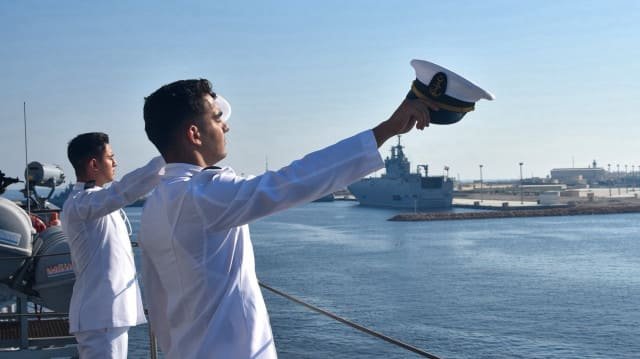The Strategic Importance of the Red Sea in Military, Political, and Commercial Sectors
Introduction to the Red Sea
The Red Sea has long been a crucial waterway connecting the East and the West, serving as a vital link between the Mediterranean Sea and the Indian Ocean. Its strategic location has made it a key passage for trade, military operations, and political developments for millennia. With countries such as Egypt, Saudi Arabia, and Sudan bordering its shores, the Red Sea has become a focal point for commercial activities, military presence, and diplomatic engagements.
- The Red Sea’s geographic significance lies in its position as a gateway between Europe, Asia, and Africa, facilitating the transit of goods, especially oil and natural gas, through major shipping lanes such as the Suez Canal and the Bab el Mandeb Strait.
- The presence of critical chokepoints like the Strait of Bab el Mandeb, through which a significant portion of world trade flows, further underscores the Red Sea’s importance in global maritime transportation.
- Additionally, the Red Sea’s coastlines host major ports and harbors, enhancing its value as a hub for international trade and commerce. Countries like Djibouti and Israel have established key maritime facilities along the Red Sea, further solidifying its role in regional and international trade routes.
The Red Sea’s unique combination of strategic location, natural resources, and economic potential continues to attract the attention of governments, businesses, and military powers seeking to capitalize on its opportunities and address its challenges. As a result, understanding the complex dynamics at play in the Red Sea region is essential for navigating the intricate web of interests and influences that shape its military, political, and commercial landscape.
Historical Significance of the Red Sea
- The Red Sea holds immense historical significance dating back to ancient times, playing a crucial role in trade, navigation, and military conquests.
- Ancient civilizations such as the Egyptians, Phoenicians, and Greeks utilized the Red Sea as a vital trade route, connecting the Mediterranean to the Indian Ocean.
- The Red Sea facilitated the exchange of goods, ideas, and culture between East Africa, the Middle East, and South Asia, contributing to the development of these regions.
- In the 15th century, the Portuguese explorer Vasco da Gama utilized the Red Sea route to navigate to India, bypassing the overland Silk Road and establishing direct sea trade with the East.
- During the era of colonialism, European powers vied for control of the Red Sea region, leading to strategic alliances, conflicts, and the establishment of naval bases along its coastlines.
- The Suez Canal, inaugurated in 1869, further enhanced the Red Sea’s importance by providing a shortcut for maritime trade between Europe and Asia, reducing travel time and costs significantly.
- Throughout history, the Red Sea has witnessed the rise and fall of empires, the spread of religions, and the shaping of geopolitical dynamics in the Middle East and beyond.
- The historical significance of the Red Sea as a crossroads of civilizations and a gateway between continents continues to resonate in the modern era, reflecting its enduring strategic importance.
- The Red Sea holds a crucial strategic position due to its location at the crossroads of Africa, Asia, and Europe, making it a key maritime route for international trade and military operations.
- The Red Sea serves as a vital link between the Mediterranean Sea and the Indian Ocean, allowing for the passage of goods, energy resources, and naval forces.
- Major world powers, such as the United States, China, Russia, and regional players like Saudi Arabia and Egypt, recognize the military significance of the Red Sea and have established naval bases and conducted naval exercises in the region.
- The presence of these military forces underscores the importance of the Red Sea in ensuring maritime security and safeguarding international shipping lanes.
- Control over key chokepoints in the Red Sea, like the Bab-el-Mandeb, gives countries strategic leverage in influencing global trade and military movements.
- Countries strategically position their naval assets near the Red Sea to protect their interests and respond to security threats that may arise in the region.
- The Red Sea’s proximity to conflict zones in the Middle East, such as Yemen and the Horn of Africa, further highlights its military significance as a potential hotspot for regional and international conflicts.
- Military presence in the Red Sea allows nations to project power, deter adversaries, and respond swiftly to emerging security challenges in the surrounding areas.
Utilizing the strategic location of the Red Sea has become imperative for nations seeking to assert their influence in the region and maintain control over vital maritime routes.
Key Military Bases and Alliances Surrounding the Red Sea
- The Red Sea region is strategically significant due to the presence of key military bases and alliances that surround it.
- Djibouti: Djibouti hosts military bases for several countries, including the United States, China, France, and Japan. The US base, Camp Lemonnier, is a key strategic asset in the region.
- Saudi Arabia: Saudi Arabia has military bases along its Red Sea coast, such as King Faisal Air Base and King Abdulaziz Naval Base, enhancing its military presence in the area.
- Egypt: Egypt’s ownership of the Sinai Peninsula gives it control over the eastern side of the Red Sea, while hosting key military installations like Ras Banas and Shalateen.
“These military bases play a pivotal role in safeguarding maritime routes and ensuring regional security.”
- Alliances: The Red Sea region also sees various military alliances bolstering security in the area.
- The Combined Task Force 150 (CTF 150), a multinational coalition, conducts maritime security operations in the Red Sea to counter terrorism and promote maritime stability.
- The Saudi-led coalition in Yemen aims to restore stability in the region, particularly concerning the Bab el Mandeb strait, a crucial chokepoint connecting the Red Sea to the Gulf of Aden.
“These alliances strengthen military cooperation and contribute to stability in the Red Sea region.”
In essence, the presence of key military bases and alliances surrounding the Red Sea underscores its critical importance in military strategy and regional security efforts.
Role of the Red Sea in Geopolitics
- The Red Sea plays a vital role in geopolitics due to its strategic location, connecting the Mediterranean Sea to the Indian Ocean.
- It serves as a significant maritime route for global trade, with thousands of commercial vessels passing through its waters annually.
- Control over the Red Sea can provide a significant advantage in naval operations and the ability to project power in the region.
- Countries bordering the Red Sea, such as Egypt, Saudi Arabia, Sudan, Eritrea, and Djibouti, have vested interests in maintaining security and stability in the area.
- The Red Sea is also a crucial passage for oil transportation, with major oil-producing countries like Saudi Arabia exporting their oil through the Suez Canal, which connects to the Red Sea.
- Geopolitical tensions in the region, such as the conflict in Yemen and the rivalry between Iran and Saudi Arabia, have direct implications for the security and stability of the Red Sea.
- Major world powers, including the United States, China, and Russia, closely monitor developments in the Red Sea as part of their geopolitical strategies in the Middle East and Africa.
- The Red Sea holds immense commercial significance due to its strategic location connecting Europe, the Middle East, and Asia, making it a vital trade route for global commerce.
- The Suez Canal, which connects the Red Sea to the Mediterranean Sea, is a crucial waterway that facilitates the transportation of goods between Europe and Asia, saving time and costs for shipping companies.
- The ports along the Red Sea coast, such as Jeddah in Saudi Arabia and Port Sudan in Sudan, play a critical role in handling cargo and facilitating trade activities.
- The Red Sea region is rich in natural resources and is a key area for oil and gas exploration, attracting investments from international energy companies.
- The tourism industry along the Red Sea is flourishing, with countries like Egypt and Saudi Arabia developing luxury resorts and attracting visitors from around the world.
- Maritime security is essential for maintaining the commercial significance of the Red Sea, as piracy and other security threats can disrupt shipping lanes and impact trade activities.
- The Red Sea also serves as a gateway to the markets of Africa, providing access to emerging economies and fostering trade relationships between countries in the region and beyond.
Major Trade Routes and Ports in the Red Sea Region
The Red Sea region has been historically significant due to its major trade routes and strategic ports. Here are some of the noteworthy trade routes and ports in the Red Sea region:
- Bab-el-Mandeb Strait: Situated at the southern entrance of the Red Sea, the Bab-el-Mandeb Strait is a crucial chokepoint that connects the Red Sea to the Gulf of Aden and the Indian Ocean. It is a vital trade route for ships traveling between Europe, Asia, and Africa.
- Suez Canal: The Suez Canal, located in Egypt, is another critical trade route that connects the Mediterranean Sea to the Red Sea. It allows ships to bypass the lengthy journey around the southern tip of Africa, making it a vital link for international maritime trade.
- Aqaba: The Port of Aqaba in Jordan is an essential trade hub in the northern part of the Red Sea. It serves as Jordan’s only seaport and provides access to various landlocked countries in the region, facilitating trade and transportation.
- Jeddah: Jeddah in Saudi Arabia is a major port city on the eastern shore of the Red Sea. It is a significant commercial hub and a key entry point for pilgrims traveling to Mecca and Medina for Hajj and Umrah.
- Port Sudan: Port Sudan, located in Sudan, is a crucial port on the Red Sea known for its export of agricultural products, minerals, and livestock. It plays a vital role in Sudan’s economy and serves as a gateway for international trade.
- Djibouti: Djibouti, a small country located on the Horn of Africa, is home to the Port of Djibouti, which is a key port in the region. It serves as a major transshipment hub and provides access to landlocked countries in East Africa.
These trade routes and ports in the Red Sea region are central to global trade and commerce, connecting continents and facilitating the movement of goods and resources between countries.
Challenges and Risks in the Red Sea
- Increased geopolitical tensions: The Red Sea region is susceptible to escalating geopolitical tensions due to rivalries among regional powers, such as Iran, Saudi Arabia, and Egypt. These tensions can heighten the risk of conflict and disrupt commercial activities in the area.
- Piracy threats: The Red Sea has been a hotspot for piracy, with incidents reported in areas such as the Gulf of Aden. The presence of armed pirate groups poses a significant risk to maritime trade routes and commercial vessels passing through the region.
- Terrorism and instability: The threat of terrorism and political instability in countries bordering the Red Sea, such as Yemen and Somalia, presents a challenge to the security of the region. Extremist groups may exploit the unstable conditions to carry out attacks, jeopardizing military, political, and commercial interests.
- Environmental risks: The fragile ecosystems in the Red Sea are at risk of environmental degradation due to factors such as overfishing, pollution, and climate change. The deterioration of the marine environment can impact commercial activities such as fishing and maritime trade, posing challenges to sustainable development in the region.
- Navigation challenges: The Red Sea is a vital maritime corridor with high traffic volume, leading to potential navigation challenges, including congestion, accidents, and collisions. Ensuring safe and efficient navigation along the sea routes is crucial to avoiding disruptions and minimizing risks to commercial operations.
- Pollution in the Red Sea has been a growing concern due to maritime traffic, industrial activities, oil spills, and sewage discharges.
- The fragile ecosystem of the Red Sea faces threats from coral bleaching, overfishing, and invasive species.
- Coral reefs in the Red Sea are vulnerable to damage from human activities and climate change, impacting marine biodiversity.
- Increased maritime traffic and development projects along the Red Sea coast can lead to habitat destruction and coastal erosion.
- Efforts to address environmental issues in the Red Sea region include marine conservation projects, sustainable fishing practices, and pollution control measures.
Environmental conservation in the Red Sea is crucial for preserving its unique marine biodiversity and ensuring the long-term sustainability of the region.
Security Measures to Safeguard the Red Sea
- Enhancing naval presence: Increasing patrols and surveillance operations by naval forces from the countries bordering the Red Sea.
- Joint military exercises: Conducting joint exercises among Red Sea countries to improve coordination and response capabilities.
- Maritime security agreements: Signing agreements to promote information sharing and cooperation in combating piracy and other maritime threats.
- Utilizing advanced technology: Deploying radar systems, drones, and other technology for monitoring activities in the Red Sea.
- Coast guard capacity building: Strengthening coast guard forces to ensure effective enforcement of maritime laws and protection of coastal areas.
- Anti-piracy efforts: Collaborating with international partners to deter and respond to piracy incidents in the Red Sea.
- Intelligence sharing: Enhancing intelligence-sharing mechanisms among countries to address security challenges in the region.
By implementing these security measures, the countries bordering the Red Sea can effectively safeguard this strategically vital waterway and ensure stability and prosperity in the region.
Impact of Red Sea’s Strategic Importance on Global Economy
- The Red Sea serves as a vital maritime trade route, connecting Europe, the Middle East, and Asia. Its strategic location allows for the efficient transport of goods between these regions, contributing significantly to the global economy.
- The Suez Canal, which connects the Red Sea to the Mediterranean Sea, is a critical artery for international trade, providing a shorter route between Europe and Asia compared to the traditional route around the Cape of Good Hope.
- The Red Sea’s strategic importance also extends to its role in the transportation of oil. Major oil producers in the Middle East rely on the Red Sea to access global markets, making it a crucial passage for the world’s energy supply.
- The presence of several high-traffic ports along the Red Sea, such as Jeddah in Saudi Arabia and Djibouti in East Africa, further enhances its economic significance by facilitating trade and commerce.
- In addition to its role in trade and energy transportation, the Red Sea’s strategic location attracts investment in infrastructure development, such as ports, logistics hubs, and industrial zones, stimulating economic growth in the region and beyond.
- Geopolitical tensions or disruptions in the Red Sea could have ripple effects on global trade and the movement of goods, impacting economies worldwide. Therefore, ensuring the security and stability of the Red Sea is crucial for maintaining the smooth flow of commerce and sustaining the global economy.
The Red Sea holds significant strategic importance as a hub for energy transportation due to its geographical location and proximity to key global energy markets. The sea serves as a vital maritime route for the transportation of oil and gas from the Middle East to Europe, Asia, and beyond. Its strategic location enables ships to bypass the long and costly journey around the southern tip of Africa, saving time and resources.
- The Red Sea is home to major oil and gas pipelines, including the East African Crude Oil Pipeline and the Sumed Pipeline, which transport oil from the Red Sea coast to the Mediterranean Sea.
- Moreover, several major ports along the Red Sea, such as Jeddah in Saudi Arabia and Port Sudan in Sudan, serve as crucial hubs for the export and import of energy resources.
- The Suez Canal, a key waterway connecting the Red Sea to the Mediterranean Sea, further enhances the region’s importance for energy transportation, allowing for the efficient transit of oil tankers and liquefied natural gas (LNG) carriers.
The stability and security of the Red Sea are paramount for ensuring the uninterrupted flow of energy resources to global markets. Any disruptions in the region, whether due to political tensions, piracy, or other security challenges, can have significant implications for global energy security and prices.
In light of the Red Sea’s critical role in energy transportation, countries and stakeholders must work together to enhance maritime security, invest in infrastructure development, and promote cooperation to safeguard the sea’s vital contribution to the global energy supply chain.
Maritime Piracy in the Red Sea: A Threat to Security
- Maritime piracy in the Red Sea poses a significant threat to security in the region.
- Pirates operating in the Red Sea target commercial vessels, including oil tankers and cargo ships, causing disruptions to international trade and commerce.
- The strategic location of the Red Sea as a key maritime route makes it an attractive target for pirate activities.
- Pirate attacks in the Red Sea not only endanger the safety of crew members and passengers but also result in significant economic losses.
- International efforts, such as naval patrols and security cooperation agreements, have been implemented to combat maritime piracy in the Red Sea.
- Despite these efforts, continued vigilance and cooperation among countries in the region are essential to effectively address the threat of piracy in the Red Sea.
Naval Power Dynamics in the Red Sea Region
The Red Sea region holds significant strategic importance in terms of naval power dynamics. Several countries with naval capabilities have interests in the Red Sea due to its vital location as a gateway between the Mediterranean Sea and the Indian Ocean. The presence of major global powers and regional actors in the region has led to a complex interplay of military postures and alliances.
- Power Projection: Naval forces in the Red Sea allow countries to project power beyond their borders and exert influence over trade routes and key maritime chokepoints. This capability enables states to protect their national interests and respond to potential security threats in the region.
- Maritime Security: Ensuring maritime security is a top priority for countries in the Red Sea region. Navies play a crucial role in safeguarding shipping lanes, combating piracy, and deterring illicit activities such as smuggling and terrorism. Cooperation among naval forces is essential to maintaining stability and promoting economic development in the area.
- Competition and Rivalry: The presence of multiple naval powers in the Red Sea has led to competition and rivalry among states vying for influence and control. Tensions can arise from territorial disputes, conflicting interests, and differing security priorities, which require diplomatic efforts to manage and mitigate potential conflicts.
- Strategic Partnerships: Many countries in the Red Sea region engage in strategic partnerships with global powers to enhance their naval capabilities and address common security challenges. These alliances often involve joint exercises, intelligence sharing, and capacity-building initiatives to strengthen maritime security and promote stability in the area.
In summary, naval power dynamics in the Red Sea region play a crucial role in shaping military strategies, political alignments, and commercial activities. The strategic significance of the Red Sea as a maritime thoroughfare underscores the need for cooperation, dialogue, and multilateral engagement to maintain peace and security in the region.
Foreign Military Presence in the Red Sea
- Over the years, the Red Sea has witnessed a significant increase in foreign military presence, with various nations establishing bases and conducting naval operations in the region.
- Countries such as the United States, China, Russia, France, and Saudi Arabia have all demonstrated a keen interest in securing a foothold in the Red Sea due to its strategic location and importance for global trade.
- The United States, for example, maintains a military base in Djibouti as part of its efforts to combat terrorism in the region and ensure freedom of navigation through key maritime chokepoints.
- China has also established a military base in Djibouti, marking its first overseas military installation, as part of its Belt and Road Initiative and to safeguard its economic interests in Africa.
- Russia maintains a naval logistics base in Sudan, allowing it to extend its influence in the region and gain access to valuable trade routes.
- France, with territories in the Indian Ocean neighboring the Red Sea, has a military presence in Djibouti and contributes to maritime security efforts in the area.
- Saudi Arabia, a key player in the region, has military bases in Eritrea and Djibouti, strategically positioning itself to protect its interests and ensure regional stability.
- The foreign military presence in the Red Sea underscores the geopolitical importance of the region and the ongoing competition among global powers to maintain influence and control over key maritime routes.
Legal Framework Governing Activities in the Red Sea
- The Red Sea is of significant geopolitical importance due to its strategic location connecting the Middle East, Africa, and Asia.
- Several international conventions and agreements regulate activities in the Red Sea region.
- The United Nations Convention on the Law of the Sea (UNCLOS) establishes the legal framework for maritime activities, including navigation, fishing, and resource exploitation.
- UNCLOS also defines exclusive economic zones (EEZs) and territorial waters, which impact the rights and responsibilities of coastal states in the Red Sea.
- Coastal states bordering the Red Sea have sovereignty over their territorial waters but must comply with international law, including UNCLOS, when it comes to navigation rights and environmental protection.
- The Red Sea serves as a vital maritime route for international trade, necessitating adherence to international law to ensure freedom of navigation and prevent conflicts.
- The International Maritime Organization (IMO) sets regulations for shipping and maritime activities in the Red Sea to promote safety, security, and environmental protection.
- Regional organizations such as the Red Sea and Gulf of Aden Commission work to enhance cooperation among Red Sea states, addressing common challenges and promoting sustainable development.
- Engaging in activities in the Red Sea requires compliance with various legal instruments to ensure stability, security, and cooperation in the region.
- Upholding the legal framework governing activities in the Red Sea is essential for promoting peace, security, and economic prosperity for the countries bordering this critical waterway.
- Red Sea rim countries have historically maintained diplomatic relations to ensure stability and security in the region.
- An example of this collaboration is the Djibouti Code of Conduct, which promotes maritime security and cooperation among Red Sea and Gulf of Aden countries.
- Saudi Arabia and Egypt have strong diplomatic ties, working together on various regional issues and military operations.
- Eritrea and Ethiopia recently signed a peace agreement, signaling a significant shift in their relationship and contributing to regional stability.
- The United Arab Emirates plays a vital role in the Red Sea by establishing military bases and investing in infrastructure projects in various countries.
- China’s growing presence in the Red Sea region has sparked both economic opportunities and concerns among other countries.
- Sudan’s evolving relationship with different Red Sea nations has implications for the region’s political dynamics and security landscape.
- The Red Sea serves as a backdrop for important multilateral initiatives and dialogues aimed at fostering cooperation and resolving disputes among member states.
- Ongoing diplomatic efforts among Red Sea countries are crucial for addressing shared challenges, promoting economic development, and enhancing regional security.
- The Red Sea is poised to continue as a vital maritime route for global trade, with its strategic location connecting the markets of Europe, Africa, and Asia. The ongoing expansion of ports and infrastructure along its shores is expected to further boost its significance in commercial shipping.
- As countries surrounding the Red Sea seek to capitalize on its strategic importance, competition for influence in the region is likely to intensify. This could lead to increased militarization and power struggles, presenting challenges for maintaining stability and security in the area.
- Climate change poses a significant threat to the Red Sea region, with rising sea levels and temperatures impacting marine life and coastal communities. Addressing environmental issues and promoting sustainable practices will be crucial to preserving the marine ecosystem and supporting the livelihoods of those who depend on the sea for their income.
- The potential for resource exploration, particularly in oil and gas, presents opportunities for economic development in the Red Sea region. However, balancing economic interests with environmental conservation and local community needs will be essential to prevent exploitation and ensure long-term sustainability.
- Cooperation among Red Sea countries to address common challenges and harness opportunities for mutual benefit will be key to shaping the future of the region. Diplomatic efforts, dialogue mechanisms, and multilateral agreements can help build trust and promote peaceful engagement among regional stakeholders.
- Overall, the future prospects for the Red Sea are promising, given its economic potential and strategic significance. However, navigating the complex geopolitical dynamics and environmental pressures facing the region will require careful planning, cooperation, and forward-thinking strategies from all stakeholders involved.
- The Red Sea holds immense strategic importance in military, political, and commercial realms due to its unique geographical location and significance as a maritime trade route.
- Military powers have historically sought control over key points along the Red Sea to secure their interests, monitor maritime traffic, and project power in the region.
- The political dynamics surrounding the Red Sea are complex, with multiple nations vying for influence and strategic advantages, leading to diplomatic maneuvers and alliances.
- Commercially, the Red Sea serves as a vital artery for global trade, offering a direct link between Europe, Asia, and Africa, facilitating the transportation of goods and resources.
- Ongoing developments and investments in ports, infrastructure, and economic zones along the Red Sea demonstrate its enduring importance in facilitating international trade and economic growth.
- As the Red Sea continues to evolve as a critical geopolitical and economic hub, stakeholders must navigate challenges such as security threats, environmental concerns, and competition for control to harness its full potential effectively.
- The strategic significance of the Red Sea underscores the need for tailored policies, cooperation among stakeholders, and a comprehensive understanding of the region’s complexities to promote stability, prosperity, and security for all involved parties.
ضخ الغاز من أذربيجان إلى سوريا عبر تركيا
مؤتمر حل الدولتين يطالب بتسليم غزة للسلطة
وفد تركي يزور قاعدة الإسكندرية البحرية
لا توجد مقالات














